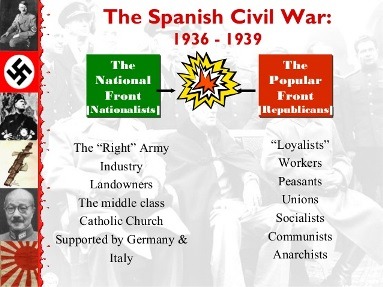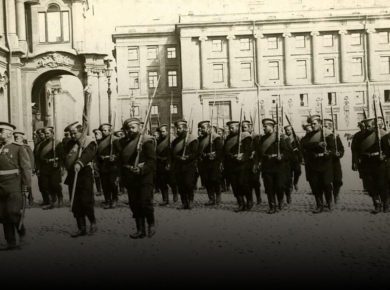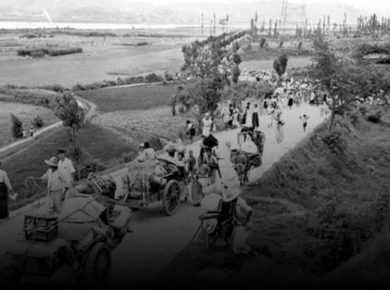Fascist Aggression between the Two World Wars
In 1930s the fascist powers began their wars of conquest which ultimately led to the Second World War. The major fascist countries were Italy and Germany. They acquired an ally in the militarist regime which came to power in Japan viz. wars against China and Russia, the conquest of Korea and her acquisition of the German spheres in China after the First World War.
- These three started series of aggression in Europe, Asia & Africa.
- All of them claimed to have been fighting against communism and were united in 1937 under the Anti-Comintern Pact.
- Germany, Italy and Japan came to be known as Axis Powers.
- When the acts of aggression began, the aggrieved countries, Soviet Union & many other countries of the world demanded collective action against the aggression.
- In 1935, the Communist International advocated the formation of Popular Fronts consisting of Communists, Socialists and other antifascists to counter the danger of fascism.
- Comintern’ s advocacy of uniting all antifascist forces was followed by the formation of Popular Fronts in many countries.
- The policy of Popular Front also had a significant influence in bringing together various anti-imperialist forces in the colonies.
Why Fascist Aggression Got Succeeded
Covenant of the League of Nations contained a provision for economic & military sanctions and collective action against aggression. However, the Western governments, instead of resisting the aggressions, followed a policy of appeasement of the aggressive powers.
- Germany, Italy & Japan which launched a series of aggressions in the 1930s claimed that they were fighting communism.
- Hitler had time & again declared that Germany had ambitions of conquering the vast resources and territory of the Soviet Union.
- Since the success of the Russian Revolution, the Western countries had been haunted by the danger of communism and they hoped that fascist countries would rid them of this danger.
The landowners, aristocrats, industrialists, bankers, high churchmen, army leaders – magnates of every kind in Western Europe, together with many middleclass elements – had never lost their fear that their own workers and peasants might demand a social revolution, perhaps one spearheaded and organized by communists. Their support of fascism as a force, albeit a gangster one, which would defeat communism and at the same time leave the vested interests largely in control, had been instinctive and sincere.
Japanese Invasion of China
- One of the first major acts of aggression after the First World War was the Japanese invasion of China in 1931.
- A minor incident involving a railway line owned by the Japanese in Manchuria, the north-eastern province of China, was made the pretext for the invasion.
- China, a member of the League of Nations, appealed to the League for sanctions against Japan to stop the aggression.
- However, Britain and France, the leading countries in the League, were completely indifferent to the appeal and acquiesced in the aggression.
- Japan occupied Manchuria, installed a puppet government there & proceeded to conquer more areas. The United States also did nothing to counter the aggression.
- In 1933, Japan quit League of Nations. It had also started seizing the British and American property in China.
- However, the appeasement of Japan continued, as the Western countries thought that the Japanese could be used to weaken China as well as the Soviet Union.
- Britain had an additional reason as it did not want to alienate Japan and thus endanger her possessions in Asia.
German Militarization
- Germany had been admitted to the League of Nations sometime after its formation but soon after Hitler came to power.
- Hitler quit the League and undertook a massive programme of militarization.
- According to the Treaty of Versailles, severe restrictions had been imposed on the military strength of Germany.
- The beginning of German remilitarization in violation of the Treaty created a sense of insecurity in many countries, particularly France.
- It was in this situation that the Soviet Union became a member of the League in 1934.
- However, nothing was done to stop German remilitarization.
- According to the Treaty of Versailles, the German area bordering France called the Rhineland had been demilitarized to make a German attack on France difficult.
- In 1936, Hitler’s troops entered Rhineland in violation of the Treaty. Though this step alarmed France, nothing was done to stop Germany.
Italian Invasion of Ethiopia
- In 1935, Italy invaded Ethiopia.
- On the appeal of Ethiopia, the League of Nations passed a resolution condemning Italy as an aggressor.
- The resolution also mentioned the use of economic sanctions against Italy, including a ban on the sale of arms to Italy.
- However, no action was taken to punish Italy and by 1936 Italy had completed the conquest of Ethiopia.
The Spanish Civil War
The next event which marked the beginning of an alliance between Germany and Italy was the intervention by these two countries in Civil War in Spain.
- In 1931 Spain became republic.
- In 1936 a Popular Front comprising Socialist, Communist and other democratic and antifascist parties came to power.
- A section of the army under the leadership of General Franco with the armed support of Italy & Germany revolted against the government.
- Italy & Germany started intervening openly in the Civil War that followed.
- They sent forces, tanks & warships in support of the rebels.
- German aircrafts conducted air raids on Spanish towns and villages.
- The government of the Spanish Republic appealed for help against the fascists.
- Only the Soviet Union came to the help of the Republican forces.
- Britain and France advocated a policy of non-intervention and refused to give any aid to the government of Spain.
- They remained Indifferent to the German & Italian intervention in the war.
However, the cause of the Republicans evoked tremendous response the world over.
- Thousands of antifascist volunteers from many countries including many antifascist Germans were organized into international brigades who went to Spain and fought alongside the Spaniards against fascism.
- Thousands of them were killed in Spain.
- Some of the best writers and artists of the 20th century actively supported the cause of the Republicans.
- The sacrifice of their lives by thousands of non-Spaniards in Spain in the cause of freedom and democracy is one of the finest examples of internationalism in history.
The Civil War in Spain continued for three years. About a million people were killed in the war. Finally, the fascist forces under General Franco succeeded in destroying the Republic in 1939. Soon the new government was recognized by most of the Western powers.
The victory of fascism was the result of the Western countries’ appeasement of fascism, which made the fascist countries more aggressive.
The Munich Pact
- Munich Pact was the final act of appeasement of fascism by the Western powers.
- While the Spanish Civil War was still going on, Hitler’s troops marched into Austria in March 1938 and occupied it.
- Even though this was a violation of the peace treaties signed after the First World War, Western powers did not protest against it.
- Hitler claimed a part of Czechoslovakia called Sudetenland which had substantial German population.
- This area formed about 1/5th of the area of Czechoslovakia and had one of the largest munition factories in the world.
- Instead of meeting the threat posed by Germany, the Prime Ministers of Britain & France met Hitler & Mussolini at Munich in Germany in 1938 and agreed to Germany s terms without the consent of Czechoslovakia.
- By 1939 entire Czechoslovakia was occupied by Germany.
Munich Pact as the last major act of appeasement by the Western powers
- The only way the fascist aggression could have been checked & another world war prevented was an alliance of the Western powers with the Soviet Union
- However, the Western policies of appeasement had convinced the Soviet Union that their main interest was to divert the German expansion towards the Soviet Union.
- The Munich Pact was an additional proof to the Soviet Union that the Western powers were trying to appease Germany with a view to directing her aggression eastward against the Soviet Union.
- The Soviet Union at this time signed a Non-Aggression Pact with Germany in August 1939.
- The signing of this Pact by the Soviet Union shocked antifascists the world over.
- Thus Britain & France promised to come to the aid of Poland, Greece, Rumania & Turkey in case their independence was endangered.











1 comment
thankyou very much to share the knowledge.